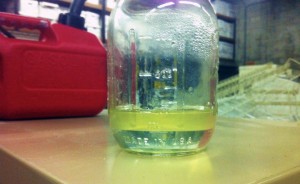Summer is finally upon us. It is a great time to be in Southwest Florida, especially if you own a boat! The tarpon are rolling in, Grouper seasons are opening and the wind is actually calming down. So whether you’re a charter captain, an avid fisherman, or a recreational boater, now is the time to be out there. Before you launch your boat though, there are several things you need to remember. The usual checklist: life jackets, fire extinguisher, air horn, throwable PFD, spot light, tackle box, fishing poles, cooler, sun screen, oh, THE PLUG!… and the list goes on. But what about the one thing that actually allows you to get where you want to go? Unless you plan on paddling your way, your motor is a vital component to your boating experience. I’m not suggesting that you might forget you motor, but don’t forget to take care of it.
Many people take their motor for granted. Besides just changing your oil or cleaning your carburetor, you have to think about what products you’re putting in your motor. Everyone is familiar with ethanol fuel, but do you really know what it is and the effects it has on a motor? In a nut shell, it’s moonshine. Ethanol is highly refined (grain) alcohol, approximately 200 proof, that can be produced from natural products like corn or sugar cane. Although ethanol fuel is widely used because it is less costly up front, there are three main problems with using it in your boat: phase separation, deterioration of fuel system components, and the overall cost of keeping your boat operational.
Phase separation is the separation of water and ethanol from fuel within a tank. When water is present in a tank, it bonds to the ethanol molecules in the fuel. Once the three-part mixture of water, ethanol and fuel reaches a certain point, the ethanol and water will drop to the bottom of the tank and separate from the fuel. Once this occurs, you are in danger of severely damaging your motor. Depending where your fuel inlet is located, your motor might receive the fuel portion of what is in the tank or the ethanol/water mixture. Both will cause problems with your motor. While the water/ethanol mixture will obviously cause damages, the fuel portion will be about three octane less than what it should be and therefore result in damages to your motor. Both these scenarios start with the presence of water in your fuel tank. With the humidity we have, the rains that we get, and the inherent nature of boats being on the water, let’s face it, water will get in your tank over time.
While on the topic of tanks, this is where your fuel system begins and the first point where ethanol has a chance to deteriorate your equipment. Most boat manufactures do not use fiberglass tanks anymore, however there are still several in use today. Ethanol will break down certain resins that hold the glass fibers together, allowing that debris to potentially reach your motor. Fiberglass is just one of the materials that ethanol will deteriorate. What about rubber, plastic, even some types of metal? It is true, it can deteriorate all these materials, all of which are a part of your fuel system. Many people mix additives to try to counteract the effects of ethanol, but that is a difficult and uncertain way of dealing with the problem.
Additives have been around for years, mostly to boost octane and preserve stagnant fuel for extended periods of time. More recently, additive manufactures have developed products designed specifically for ethanol treatment. The problem is, there are many different types of fuels throughout the country. They go through different refining processes, have different Reid Vapor Pressures (RVP), and they all have their own blend packages added by the major oil companies already. The chance that additive manufacturers have tested their products on all these different fuel types is highly unlikely. I wouldn’t trust my multi-thousand dollar investment on chemicals that are untested and may not be compatible with my fuel.
Furthermore, additives are expensive. Whether you are mixing in additives for ethanol compensation or to boost octane, that all has to be factored in to the overall cost of running your boat. If you add an octane booster to your fuel to make up for the efficiency you loose by running ethanol enhanced fuel, you are chasing your tail. Then factor in the cost of repairs to your fuel system and potentially your entire motor, you will be spending hundreds if not thousands more simply because you ran ethanol enhanced fuel.
In all fairness, most boat and motor manufacturers claim to have made adjustments to there manufacturing process that allow their watercrafts to accept up to 10% ethanol blended fuel. Still, the jury is out as to the long-term effects of what this fuel will do, to even the newer motors. Play it safe, protect your investment, run non-ethanol (also known as 90 Rec) fuel, and enjoy the summer waters without worrying if your motor will get you back to dry land. For more information about the advantages of non-ethanol fuel, contact your local marina mechanic or email [email protected].
Written by John Siefert, Edison Oil Company

